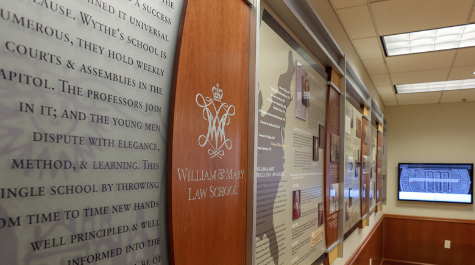The Wolf Law Library’s History Wall Tells the Law School’s Story
Project Made Possible by Generosity of the Law School’s Class of 1988
A visual story of William & Mary Law School dating back to its founding in 1779 greets visitors of The Wolf Law Library even before they reach the thousands of books and digital materials available in the three-story building.
A historical wall, which debuted late last year, decorates the left–side entrance of the library across from the circulation desk. Spanning more than thirty feet, the wall is an expansive timeline of the Law School’s unique history.
“The goal was to tell a story,” explained Lauren Seney, the school’s Digital Initiatives Librarian, who, with other Wolf Law Library staff members, brought the historical wall to life. “We knew part of it was going to be the people. It’s a history of people but also of places.”
Seney was perfect for the role as she was already working on digitizing the Law School’s long-spanning history and is an “archivist at heart.” Along with several other librarians, the team expertly wove together a historical tapestry of the nation’s first law school. The end result includes notable firsts: the first female graduate, Virginia Mister (1937); the first African-American graduate, Edward A. Travis (1954) and the addition of the first full-time tenure-track female faculty members, Lynda Butler and Ingrid Hillinger (1979). The team, in addition to Seney, included James Heller, Director of The Wolf Law Library; Linda K. Tesar, Head of Technical Services and Special Collections; Jennifer Sekula, Head of Access Services; and Fred W. Dingledy, Sr. Reference Librarian.
The wall delivers a vivid narrative. It ties in the significance of iconic buildings in Colonial Williamsburg, including the Colonial Courthouse that was used for moot court sessions for law students and the Wythe House, where the school’s first professor, George Wythe, taught classes. The wall completes its comprehensive story by highlighting the Law School’s notable alumni, faculty, journals and programs.
“We had a lot to work with,” said Seney, who described numerous meetings over the past four years to sift through visually compelling and major moments of the Law School’s history. After narrowing down the selections, entries were reviewed by Dean Davison M. Douglas and other librarians, and checked for accuracy by Virginia historian W. Hamilton Bryson, who is the Blackstone Professor of Law at the University of Richmond School of Law.
Some of the finds even surprised the team, including the effect wars had on education in Williamsburg. For example, the wall details how the university’s finances collapsed after the Civil War. As a result, William & Mary greatly reduced its faculty and the number of classes it offered and would not restore a formal law program until the early 1920s.
The team dug up more than could be included in the physical display, and they found a new home online for the vast historical snippets. The digital version of the online “wall” – which you can visit here – will continue to be updated as the Law School adds to its growing story. While the library’s display has been a great eye-catcher for students, faculty and visitors, Seney believes the online version will be of interest to alumni across the world and may reveal tidbits about their alma mater they may not have known.
The historical exhibit was made possible by a generous donation from the Law School’s Class of 1988. The wall includes a commemorative plaque thanking the class for its support. The school will host a dedication celebration during Alumni Weekend on April 12.
Partners In Recognition, Inc., the company that handled the installation of a similar display for the William & Mary School of Education, also oversaw the installation and production of the Law Library’s wall.
About William & Mary Law School
Thomas Jefferson founded William & Mary Law School in 1779 to train leaders for the new nation. Now in its third century, America's oldest law school continues its historic mission of educating citizen lawyers who are prepared both to lead and to serve.
